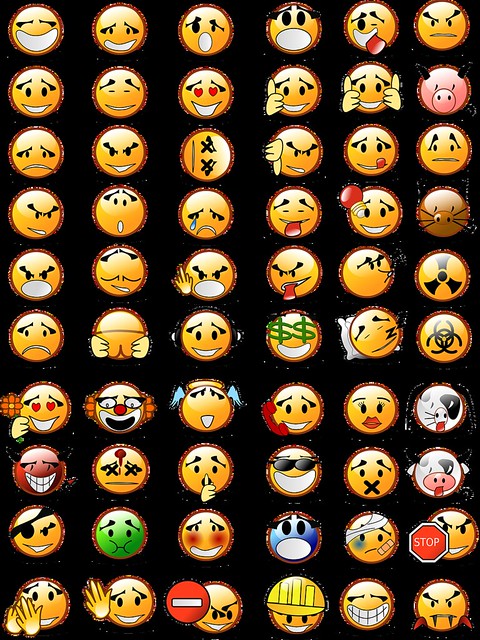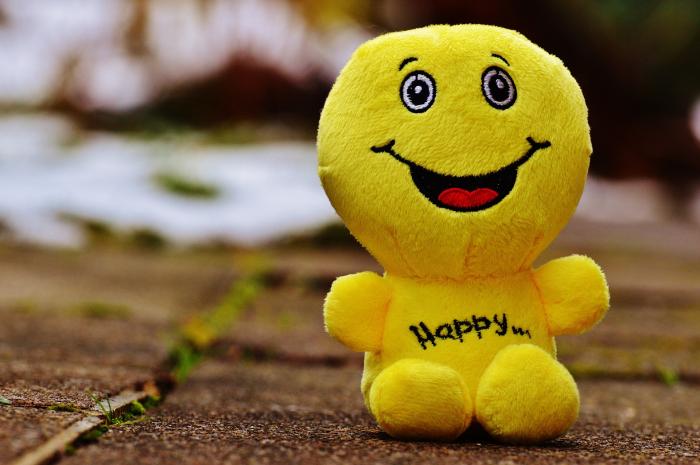The smiling face, i.e. the smiley, is an inseparable part of modern culture. Pop culture generally likes to play with opportune and simple symbols.
Appearing initially in the physical then virtual world, the smiley is part of a big industry and at the same time, a language of communication.
It was used from the beginning in written communications and social media chats, for additional emotional emphasis, then it branched out and spread so much that it now threatens to be not only an attachment to text, but also text itself.
The smiley conveys emotions in graphic form — not with words. More precisely, it is used when words are not enough, or when you have create the illusion of a live conversation (after all, the conversation participants don’t see each other).
The first smileys were portrayed with punctuation marks: two dots and a parenthesis. The position of the parenthesis conveys a happy or unhappy mood. That is, the emotion was both and the opposite, then it became a narrative and was enriched with nuances. It itself became a language.
 The first smiling face
The first smiling face
Image credit: IkamusumeFan
Later, the smiley adopted color and more detailed facial features and accessories (nose, eyebrows, glasses, gloves, hats, and so on), which allowed to convey not only a smile, but also a grin, laughter, widespread happiness and widespread surprise — as well as depict unpleasant moods and emotional states: pain, lamentation, crying, and so on.
Smileys depicted using punctuation marks need special decoding. That is, the new language needs a new dictionary. And that dictionary will never be complete, since messages and online posts gradually remain less within the limits of text and more so replaced by universal graphic signs-hieroglyphs.
See below for a few smileys with which you can communicate, understand, and be understood without words.
The onslaught of smileys, and emoticons in general, drastically changed the platform for communication, making it homogeneous, universal, and more easily digestible.
Let’s recall a few historical facts. Happy faces entered mass circulation in 1962, when winners of New York radio station WMCA’s quiz were rewarded with a sweatshirt with the happy face on it. But those first smileys were partly smiling — it wasn’t the full and wide smile to which we are accustomed.
 Sweatshirts provided by WMCA radio station
Sweatshirts provided by WMCA radio station
Photo credit: Wikipedia
The color yellow became enshrined later, and in 1972, the French newspaper France Soir began a campaign with the slogan “Find time to smile.” The point of the campaign was that readers were given the chance to make a choice between good/positive and problematic/negative news. The good news were accompanied by smileys, and if someone wanted to read something positive, they would immediately see what they should read and what they could skip.
It’s an interesting paradox: when the difficult and complicated increase in society, very basic symbols are used as a counterbalance: images of cats, concise minimalist signs (dot, dot, comma, kiss, hearts) and finally, smileys.
They are the kitschy stylings of the emerging internet culture, through which, on one hand, you can be protected from the difficult and the negative, but, on the other hand, you can present yourself as an observer. After all, by going to emoticons for help, we are supposedly saying something while simultaneously saying nothing.
The smiley is an image deprived of an individual stamp and style, and its demonstratively faceless (though it is a face) form allows the user to remain anonymous: I am silent, I don’t search for words, I use a smiley… on one hand, I’m participating in the conversation; see, I’m investing emotion; while on the other hand, I am not allowing you to recognize me or my thoughts.
That is, I’m conversing, but I’m doing so not fully. I notice that I’m present, but what I’ve mentioned is not completely me.
 Image credit: ClkerFreeVectorImages
Image credit: ClkerFreeVectorImages
With smileys, you can now express your thoughts through not only an emotion, but also an entire sentence and even write some text. The words recede, since words are a reflection of language (hence, the inner world), while the smiley is a universal, international sign, which doesn’t need to be translated, made understood, or interpreted. Or rather, it can be interpreted, but the interpretation will be with another smiley or with another cute and colorful emoticon, which is not something we created (like a personally authored post) but created for everyone (without exception).
Words now don’t feel safe in text; they are no longer the only one in that big playing field that conveys thought and motivates the conversation participant or reader to plunge into the text, to understand it.
This new online language undoubtedly affects readers’ or users’ understanding of written texts. For example, it might be the case that you write something and you are asked, was that a joke? You say, yes, of course. Answer: if it was a joke, why didn’t you use a smiley?
That is to say, without prompting how something should be read, it already fails. Smileys guide, clarify, and simplify the writing.
In Armenia too they are trying to provide news stories with the guiding and decorative use of smileys — it can be said, to label the lighter, non-imposing news articles with a positive and smiling small ball.
Someone recently complained to me that they can’t read literary texts because what the author wanted to say is unclear. They even opined that it would be good to make certain literary works readable and to translate them to a new language — by inserting smileys in necessary places as breaks.
This reality is neither bad nor good. It’s new. And as with any new thing, it seems dangerous as long as the danger doesn’t become routine.
Now imagine, you’re reading a book with prompts on what emotion should be inserted where. In the case of good literary texts, that’s impossible, since… it’s impossible. A good text is so compact and self-sufficient that it simply cannot be watered down with smiley tips. The text will resist. Then it will wink at the reader 😉 …
Nune Hakhverdyan
P.S. According to netiquette (etiquette on the internet), the maximum number of smileys in one post cannot exceed three. Misuse is an indicator of poor taste. ☺







